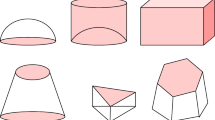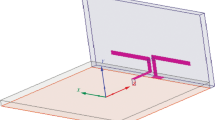Abstract
In this paper a triple-band dielectric resonator antenna (DRA) is designed using a 0.8 mm thicker Arlan FR-25 substrate, having relative dielectric constant of 3.58 and loss tangent of 0.0035. The antenna works in three unique frequency bands of 15, 16.3 and 18.5 GHz, lying in the sub-20 GHz spectrum. A stack of ten radiating elements of AR100 material, are installed at the centre of the proposed antenna structure. The DRA is excited through an elliptical aperture in the metallic plane via a 50 Ohm microstrip feed line, etched on the rear side of the Arlan FR-25 substrate. Stacked parasitic elements are incorporated around the central radiating element for achieving enhanced gain. The proposed DRA gives satisfactory gain and fractional bandwidth of (8.06 dB, 12%), (10.7 dB, 3%) and (7.03 dB, 2.73%) at 15, 16.3 and 18.3 GHz bands, respectively. The simulation results of the DRA are compared and validated using three different analysis techniques i.e., FIT (Finite Integration Technique), FDTD (Finite Difference Time Domain) Method and FEM (Finite Element Method). The designed antenna can be used for future fifth generation (5G) systems (15 GHz), internet of things (IoT) based device-to-device (D2D) communication and satellite applications (16.3–18.3 GHz).









Similar content being viewed by others
References
Kitanov, S., Monteiro, E., Janevski, T. (2016). 5G and the Fog: Survey of related technologies and research directions. In 2016 18th Mediterranean Electrotechnical Conference (MELECON), pp. 1–6.
Zhang, J., Tang, P., Tian, L., Hu, Z., Wang, T., & Wang, H. (2017). 6–100 GHz research progress and challenges from a channel perspective for fifth generation (5G) and future wireless communication. Science China Information Sciences, 60(8), 080301.
Theodore, P. (2016). Spectrum frontiers: The new World of millimeter-wave mobile communication, p. 21.
Xu, B., et al. (2017). power density measurements at 15 GHz for RF EMF compliance assessments of 5G user equipment. IEEE Transactions on Antennas and Propagation, 65(12), 6584–6595.
Roh, W., et al. (2014). Millimeter-wave beamforming as an enabling technology for 5G cellular communications: Theoretical feasibility and prototype results. IEEE Communications Magazine, 52(2), 106–113.
Orsino, A., Araniti, G., Molinaro, A., Iera, A. (2015). Effective RAT selection approach for 5G dense wireless networks. In IEEE 81st vehicular technology conference (VTC Spring), pp. 1–5.
Shahadan, N. H., et al. (2017). Steerable higher order mode dielectric resonator antenna with parasitic elements for 5G applications. IEEE Access, 5, 22234–22243.
Allabouche, K., et al. (2017). Multiband rectangular dielectric resonator antenna for 5G applications. In 2017 International Conference on Wireless Technologies, Embedded and Intelligent Systems (WITS), pp. 1–4.
Balanis, C. A. (2005). Antenna theory: analysis and design (3rd ed.). London: Wiley.
Long, S., McAllister, M., & Shen, L. (1983). The resonant cylindrical dielectric cavity antenna. IEEE Transactions on Antennas and Propagation, 31(3), 406–412.
McAllister, M. W., Long, S. A., & Conway, G. L. (1983). Rectangular dielectric resonator antenna. Electronics Letters, 19(6), 218–219.
McAllister, M. W., & Long, S. A. (1984). Resonant hemispherical dielectric antenna. Electronics Letters, 20(16), 657–659.
Shen, C. et al. (2018). A high-gain and broadband dielectric resonator antenna array with substrate-integrated-waveguide feed network for 67GHz. In 2018 International workshop on antenna technology (iWAT), pp. 1–3.
Xie, R., Cao, J., Wang, R., Wang, X., Xu, Z., Zhu, S. (2016). A study of dielectric resonator antenna array applied to 5G communication system. In 2016 Progress in electromagnetic research symposium (PIERS), pp. 454–457.
Pepino, V. M., da Mota, A. F., Martins, A., & Borges, B. V. (2018). 3-D-printed dielectric metasurfaces for antenna gain improvement in the ka-band. IEEE Antennas and Wireless Propagation Letters, 17(11), 2133–2136.
Haraz, O. M., Elboushi, A., Alshebeili, S. A., & Sebak, A. (2014). Dense dielectric patch array antenna with improved radiation characteristics using EBG ground structure and dielectric superstrate for future 5G cellular networks. IEEE Access, 2, 909–913.
Fakhte, S., Oraizi, H., & Matekovits, L. (2017). High gain rectangular dielectric resonator antenna using uniaxial material at fundamental mode. IEEE Transactions on Antennas and Propagation, 65(1), 342–347.
Fakhte, S., Oraizi, H., & Vadjed-Samiei, M. H. (2012). A high gain dielectric resonator loaded patch antenna. Progress In Electromagnetics Research, 30, 147–158.
Pan, Y. M., & Zheng, S. Y. (2016). A low-profile stacked dielectric resonator antenna with high-gain and wide bandwidth. IEEE Antennas and Wireless Propagation Letters, 15, 68–71.
Wang, K. X., & Wong, H. (2015). A circularly polarized antenna by using rotated-stair dielectric resonator. IEEE Antennas and Wireless Propagation Letters, 14, 787–790.
Sun, W., Yang, W., Tang, H., Chu, P., & Chen, J. (2018). Stacked dielectric patch resonator antenna with wide bandwidth and flat gain. The Journal of Engineering, 2018(6), 336–338.
Vandenbosch, G. A. E., & Vasylchenko, A. (2011) A practical guide to 3D electromagnetic software tools. Microstrip Antennas.
Vasylchenko, A., Schols, Y., Raedt, W. D., & Vandenbosch, G. A. E. (2009). Quality assessment of computational techniques and software tools for planar-antenna analysis. IEEE Antennas and Propagation Magazine, 51(1), 23–38.
Simons, N. R. S., Siushansian, R., LoVetri, J., & Cuhaci, M. (1999). Comparison of the transmission-line matrix and finite-difference time-domain methods for a problem containing a sharp metallic edge. IEEE Transactions on Microwave Theory and Techniques, 47(10), 2042–2045.
Nikkhah, M. R., Rashed-Mohassel, J., & Kishk, A. A. (2013). Compact low-cost phased array of dielectric resonator antenna using parasitic elements and capacitor loading. IEEE Transactions on Antennas and Propagation, 61(4), 2318–2321.
Shahadan, N. H., Kamarudin, M. R., Jamaluddin, M. H., Khalily, M., Jusoh, M. (2016). Switched parasitic dielectric resonator antenna array using capacitor loading for 5G Applications. In 2016 10th European conference on antennas and propagation (EuCAP), pp. 1–5.
Guo, Q., & Zhang, J. (2019). A dual-band rectangular dielectric resonator antenna array for 5G applications. In 2019 IEEE MTT-S international wireless symposium (IWS), 2019, pp. 1–3.
Ali, I., Jamaluddin, M. H., Gaya, A., Rahim, H. A. (2020). A dielectric resonator antenna with enhanced gain and bandwidth for 5G applications. Sensors (Basel), 20(3).
Acknowledgements
The authors acknowledge the funding of Researchers Supporting Project number (TURSP-2020/144), Taif University, Taif, Saudi Arabia.
Author information
Authors and Affiliations
Corresponding author
Additional information
Publisher's Note
Springer Nature remains neutral with regard to jurisdictional claims in published maps and institutional affiliations.
Rights and permissions
About this article
Cite this article
Ahmad, J., Ullah, S., Khan, S. et al. Design and Synthesis of Dielectric Resonator Antenna for 5G Wireless Networks, Device-to-Device and Satellite Communications Using Different Numerical Techniques. Wireless Pers Commun 121, 815–830 (2021). https://doi.org/10.1007/s11277-021-08660-4
Accepted:
Published:
Issue Date:
DOI: https://doi.org/10.1007/s11277-021-08660-4




